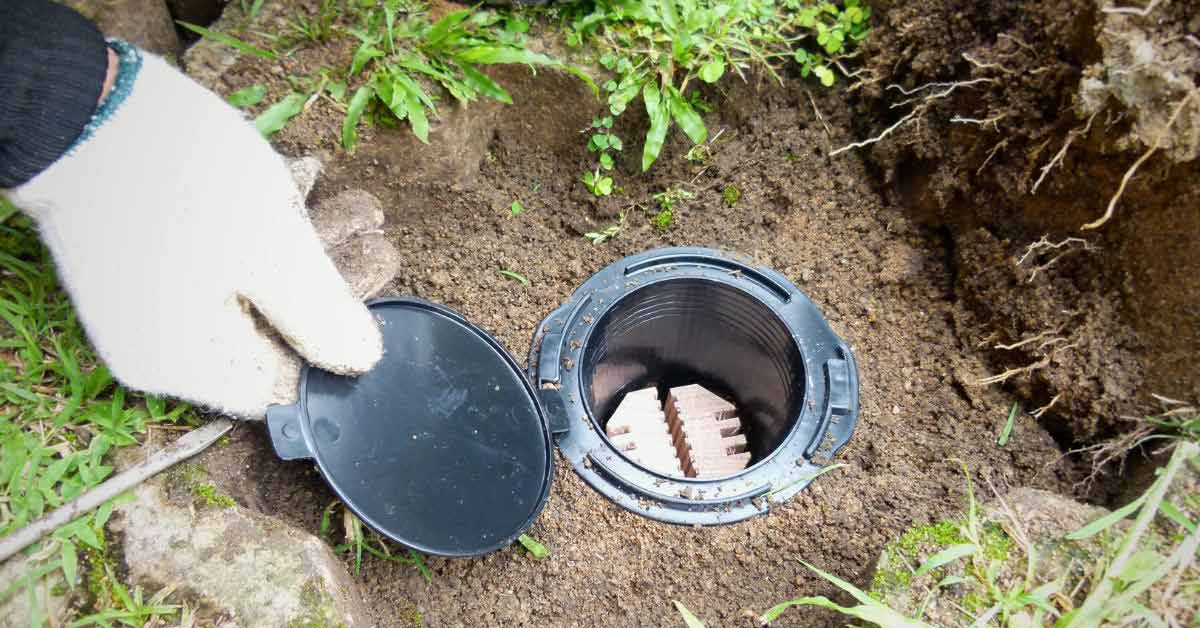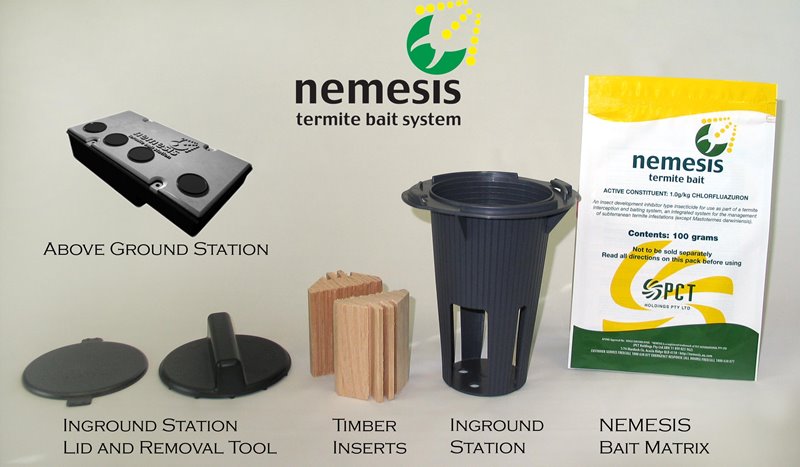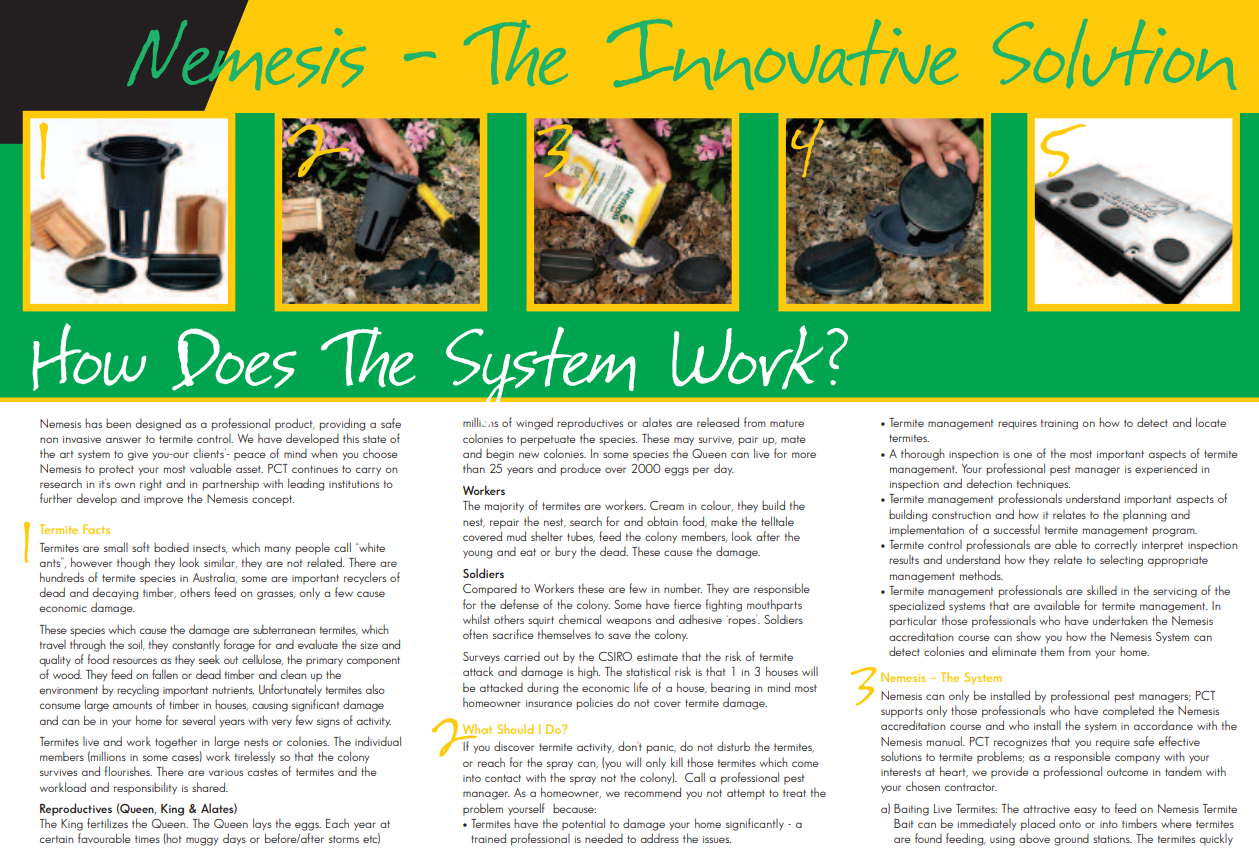Nemesis Termite Bait System
A professional product to provide a safe, non-invasive answer to termite control.
Nemesis has been designed as a professional product to provide a safe, non-invasive answer to termite control. We have developed this state of the art system to give you, our client’s, peace of mind when you choose Nemesis to protect your most valuble asset. PCT continues to carry on research in it’s own right and in partnership with leading institutions to further develop and improve the Nemesis concept.
What is Nemesis?
NEMESIS is an Australian termite bait system designed to intercept and eliminate termite colonies in a safe non-invasive way. It uses an insect growth regulator (IGR), Chlorfluazuron, as the active constituent in the Nemesis bait. Active termites feed on the highly attractive bait food source & translocate the IGR to other members of the colony, at levels undetectable by those termites, until the colony collapses. Nemesis termite bait is a registered product under the requirements of legislation administered by the Australian Pesticides and Veterinary Medicines Authority. NEMESIS is tested in accordance with and in compliance with both the APVMA and the ISO9001 requirements.
The system uses several unique stations for in-ground & above-ground interception of active termites.

Product & Termite Facts
Nemesis Inground Station.
The Nemesis station is a radical patent pending design. The station has open soil contact ports which match the voids and grooves incorporated into the design of the timber insert providing exceptional timber to soil contact and easy termite access.
Grooves and voids mimic termite workings in timber, running from top to bottom, these act as conduits for foraging termites. The top half of the station provides an enclosed humid cubicle for termites to aggregate in. The station is tapered and has a low-profile cap, with a tamper-evident securing mechanism.
Nemesis Timber Inserts.
The timber inserts, unlike those in other systems available, are designed with vertical grooves and open voids running uniformly the length of the insert. These design features maximise the surface area of the timber, which regulates the number of termites that will enter the station. They also provide tracks for foraging termites mimicking termite workings in timber. Additionally, the grain of the timber runs vertically upwards when the two timber inserts, which fit in the station, are positioned in line with the grooves and voids of the station. These innovative design features entice the foraging termites upwards into the large open chamber to aggregate, when the Nemesis Termite Bait can be loaded.
The open chamber allows easy vision of the grooves and voids, greatly improving the ease of detection of foraging termites, whilst minimizing the likely disturbance of termites during the inspection or baiting phases.
Nemesis above ground station.
The Nemesis Above Ground Station has been designed as a flexible, easy-to-install solution for managing termite activity in active termite above ground areas.
The above ground station can be a standalone system where at a site in-ground installation isn’t practical. Built for convenience and efficiency, the station allows pest management professionals to apply Nemesis bait directly into known termite feeding sites, such as active mud leads or within infested structures. Its durable, discreet design ensures it can be positioned securely on vertical surfaces, timber framing, or other problem areas. The station is also easy to open and refill, making it ideal for ongoing monitoring and treatment. This innovative system enhances versatility in termite control, allowing for effective colony elimination in both residential and commercial settings.
Nemesis termite bait.
The bait is based upon proven insect growth regulator technology. Chlorfluazuron, the insect growth regulator used in Nemesis Termite Bait, inhibits the ability of the individual termites to synthesise chitin, and transfers Chlorfluazuron to the Queen, which renders her sterile. This has a 2-pronged effect:
- Termites moult, that is, they shed their exoskeletons, because they cannot reproduce chitin, they are unable to replace this skeleton, and thus perish, and
- As the Queen is sterile, any eggs laid are sterile and hence colonies are eliminated
The termite colony loses whole generations and collapses as a consequence.
The bait matrix is manufactured using pure food grade cellulose.
Efficacy
Chlorfluazuron has proven to be extremely effective for termite baiting because:
- It is a benzoylphenyl urea insect growth regulator that inhibits the synthesis of chitin
- Only one gram per kilo of Chlorfluazuron is required to effectively control termite colonies
- Its delayed mode of action allows widespread transfer within the colony for maximum secondary kill
- It is effective against all sub-species of subterranean termites with the exception of Mastotermes darwiniensis.
- Chlorfluazuron is practically non-toxic to mammals, birds, fish, and earthworms (Tomlin 1997)
- It slowly degrades in water
- It is strongly absorbed by soil with a Kd of 120-990
- Its half-life in soil varies from 6 weeks to a few months
Who can install Nemesis?
NEMESIS can only be installed by professional pest managers; PCT supports only those professionals who have completed the Nemesis training course and install the system in accordance with the Nemesis manual.
PCT recognises that our end-user, you, require safe effective solutions to termite problems; as a responsible company with concern for your interests, we can provide a professional outcome in tandem with your chosen installation contractor.

Why can only a professional install NEMESIS?
As a homeowner, you should always use a professional pest manager when dealing with a termite problem. We recommend that you not attempt to treat the problem yourself because:
- Termites have the potential to damage your home significantly, and thus, a trained professional is needed to address the issues.
- Termite management requires training on how to detect and locate termites.
- A thorough inspection is one of the most important aspects of termite management. Your professional pest manager is trained and experienced in inspection and detection techniques.
- Termite control professionals understand the important aspects of building construction and how it relates to the planning and implementation of a successful termite management program.
- Termite control professionals are trained to correctly interpret inspection results and understand how they relate to selecting appropriate control methods.
- Termite control professionals are trained to service the specialised systems that are available for termite management; in particular, those professionals who have undertaken the Nemesis accreditation course can show you how the Nemesis System can detect colonies and eliminate them from your home.
Consumers
Nemesis has been designed as a professional product to provide a safe, non-invasive answer to termite control. We have developed this state-of-the-art system to give you, our clients, peace of mind when you choose Nemesis to protect your most valuable asset. PCT continues to carry on research in its own right and in partnership with leading institutions to further develop and improve the Nemesis concept.
We trust the information contained in this website will assist you in evaluating Nemesis and in providing answers to your questions. Thank you for your interest in the Nemesis Termite Bait System.
Training and Support
- PCT can design and deliver specialist training for its Urban Pest manager member clients and/or for those members’ clients.
- PCT has a broad range of PowerPoint Presentations, Training modules, and specific text materials available.
- PCT can also design and deliver management systems and manuals for all aspects of urban pest management, quality assurance in urban pest management, as well as occupational and workplace safety in urban pest management.
RTV Training
- PCT is closely linked in partnership with RTV training and has assisted in the development of training modules for traineeships
- PCT has also developed and is further developing a range of additional presentations and books to cover all aspects of urban pest management.

Frequently Asked Questions
Yes- it is very effective and efficient; the system maximises the control opportunity whilst minimising the amount of material used and it’s likely impact on the environment. Termite baiting is an approved method in Australian Standard AS3660.2-2000.
Nemesis is an attractive bait for termites. The active ingredient affects the termite’s ability to grow, develop and reproduce. The offending termite colony actually eats itself to destruction.
Licensed Pest Manager’s are highly trained and experienced in important treatment aspects, such as termite biology, ecology, conducive site conditions, building construction, likely entry points, termite detection and reporting, along with integrated termite management procedures. They utilise these skills and the underpinning knowledge in a manner which, in your time of need, wiil give you peace of mind.
This can vary greatly depending on the species of termites, the size of the colony, it’s age and vigour as well as other factors, such as the availability of food soures. There are many other factors that can play a role in the speed of attack and the extent of damage. In many cases where attack is detected early, the cost of repairs can still be significant, the longer the infestation lasts the greater the cost of rectifying the problem. Termites can also damage books, clothing and a wide range of cellulose based items other than structural timbers.
Australian Standard AS3600.2-2000 advises that properties should be inspected at intervals not exceeding 12months. The Standard further advises that properties at greater risk should be inspected every 3 to 6 months, depending on the degree of risk. This should be assessed during the initial inspection.
The most common measure of risk is that 1 in 3 houses will be attacked and/or damaged by termites during the economic life of the structure; thus the risk increases with the age of the property.
DO NOT PANIC. DO NOT DISTURB THEM OR ATTEMPT TO TREAT THEM YOURSELF WITH SPRAYS OR AEROSOLS. Call a Professional Pest Manager; disturbing termites or killing termites that you can see, will only cause the colony to move to another entry point in your property to continue their destruction.
No, there are 348 Australia species. A large number of these feed on grasses, standing trees or decayed timbers. In nature their role is to recycle important nutrients. Only about a dozen species cause significant damage to structures. It is important that you engage a Professional Pest Manager to ascertain whether your property is at risk.
Try not to disturb them further. Try to collect 10-20 specimens, preferably termites with darker heads (these are soldier termites). Place these termites in a mixture of 70% methylated spirits and 30% water to preserve them for identification.
In many cases it will take 6-12 weeks, however several months may elapse before total colony elimination is effected. There are numerous factors controlling this, such as the time of year, size of the colony and species of termie involved. However, due to the effect of the Nemesis Bait, termite feeding will decline to a level that will minimise further damage. It is also important to remember that there are visible observable milestones and indicators that the Nemesis Bait is working.
